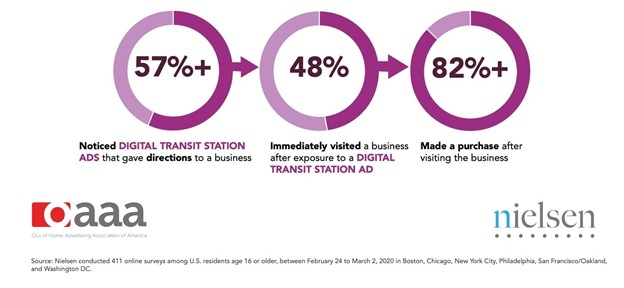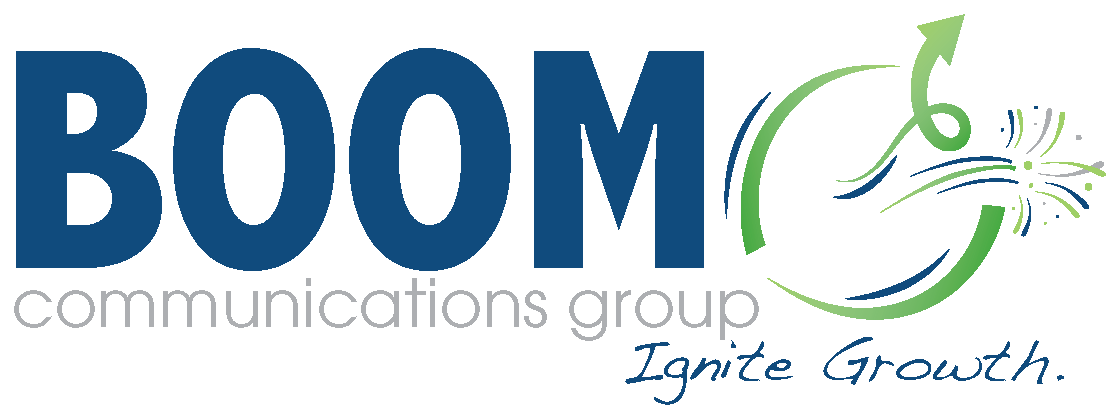
Out-of-home advertising (OOH advertising) is marketing to people throughout the day outside of their homes.
The average person spends 70% of their waking hours out of their homes. In comparison, people spend just over six hours a day on the internet on average. So, while online advertising is growing in popularity, OOH marketing is still very impactful for reaching your audience.
Let’s take a closer look at just what OOH advertising is and how your business can use it to reach your customers, even in places where the internet can’t go.
Key Takeaways:
- OOH marketing is billboard, transit, street furniture, and place-based advertisements.
- Target OOH marketing uses demographic data to place ads where your market is most likely to travel.
- Successful OOH ads are simple, concise, colorful, and creative.
- OOH ads should have a purpose or follow-up action for consumers to do.
What is OOH Advertising?
If you have ever driven down an interstate highway, you are familiar with the large billboards informing you of upcoming restaurants, hotels, and places of entertainment. Or perhaps you regularly take public transportation. In that case, you often see posters advertising insurance policies, lawyer services, or new products.
Every time you are outside and encounter an ad, you are seeing an OOH. Since the average person requires eight touchpoints before making a purchasing decision, you want to leverage every opportunity possible to expose your market to your products or services so that you attract more customers.
DOOH Advertising vs. OOH Advertising
Digital Out-Of-Home (DOOH) advertising is a fast-growing and cost-effective OOH advertising trend. DOOH uses digital displays instead of traditional static ads.
Advertisers can use DOOH to easily switch between multiple ads, change information, and create a more engaging experience with people who see the ad.
DOOH has an expected growth of $3.6 billion to $8.4 billion by 2023. However, print advertising still has a place in the marketing industry through static ads, flyers, and posters.
OOH Advertising Examples
The Out of Home Advertising Association of America divides OOH advertising into four categories. Here are some OOH advertising examples from each group.

Billboards
Billboards are by far the most effective form of OOH advertising. These range from the giant boards on the side of a highway to smaller displays you see when you walk down the street.
There are over 342,306 billboards across America. The most popular industries to advertise via billboards are:
- Real Estate
- Medical
- Home Services
- Politics
- Restaurants
Transit
The average one-way commute time in America was 27.6 minutes in 2019. Of that average, the most extended commute times were public transportation, like bus commuters with a 46.6-minute average commute.
Marketers can take advantage of those long periods people spend sitting and staring at the wall by adding marketing posters in major transit areas.
Some examples include buses, taxis, truck sides, and airports.
Street Furniture
Street furniture advertisements are eye-level ads targeting people as they are walking around their neighborhood or city. Some common locations for street ads are bus stops, kiosks, dining tables, news racks, benches, and free-standing posters.
Place-Based
The last form of advertising is place-based ads. These are posters and signs that marketers display at a specific location to target the demographic that frequents those spots. Some examples include flyers at grocery stores, planes with tail-kites at beaches, posters in clubs, and ads at the cinema.
4 Ways to Use OOH Advertising for Your Business
If you are interested in using OOH advertising for your business, here are five tips for reaching your target audience effectively.
1. Research your Market and Location
You need to know your target demographic and customer behavior like online advertising before choosing an effective marketing strategy. Learning your market includes researching where your audience is most likely to be throughout the day.
For example, if your audience is CEOs of large businesses, they usually work in the city and take public transportation. Therefore, transit ads are the best way to reach those consumers. However, if your business targets frequent travelers, you may want to take advantage of billboards along the highway or airport ads.
Your demographic is only half of your research. The second half includes finding out the best location within your demographic area. To choose where to place your ad, consider the location’s weather, visibility, and costs.
2. Use Creative Displays
DOOH advertising is one way to display engaging and creative ads. However, static ads also have many creative options, such as 3-D objects, strategic lighting, and unique backdrops like wall murals.
People are also more likely to look at your ad if it incorporates bright colors and high contrast. Including short, memorable statements will go further than long paragraphs that people can’t read in seconds while they walk (or drive) past.
If you display unique ads that create a buzz, people usually take pictures and share them over social media, giving you a wider audience.
3. Analyze Successful OOH
The average cost of a traditional billboard is between $750 and $14,000 each month. However, the cost will vary drastically depending on whether you are marketing in a major city or the country. When you invest that kind of money, you want to know your ads will be successful.
You don’t need to guess through trial and error. A Google search of “best billboard ads” will give you over 65 million results, all with ideas of successful and unsuccessful billboard campaigns. You will also want to check out your competition to see what they are doing that’s working. Next, find how you can be even more effective by adding a unique selling point that differentiates your business.
4. Have a Specific Goal
What do you want your OOH to accomplish? Your intent will dictate your ad’s design. Some common end goals for OOH include:
- Encouraging traffic to your company website
- Spreading awareness of a new product or service
- Drawing people to your physical location
- Informing people of a sale
- Spreading knowledge or a PSA
One example of an ad with an end goal is a transit ad for your business in a city metro. You could include which stop people should take on the metro to get to your physical location.

How to Start Your Campaign
If you are ready to start your OOH campaign, contact a marketing company to find the best advertising format to reach your audience. At Boom Communications, we offer strategic marketing services to help you convert your OOH leads.
Contact us today to get a quote and discuss your next marketing strategy.
